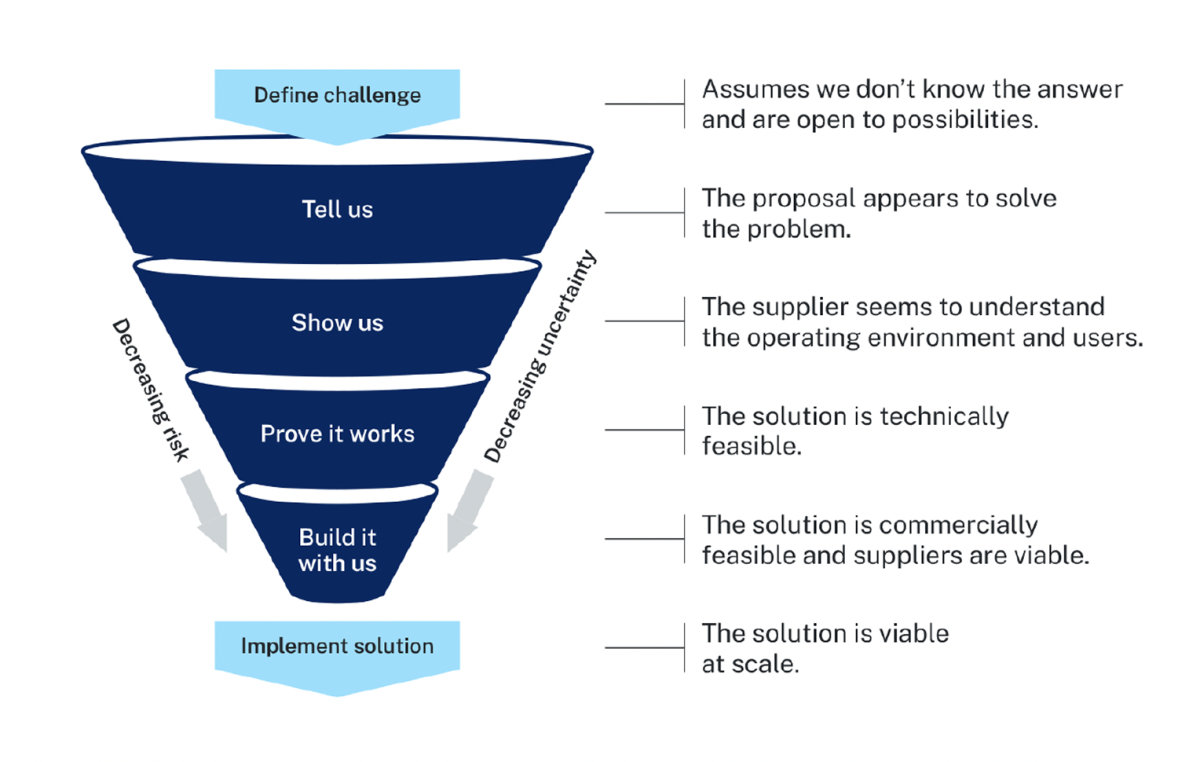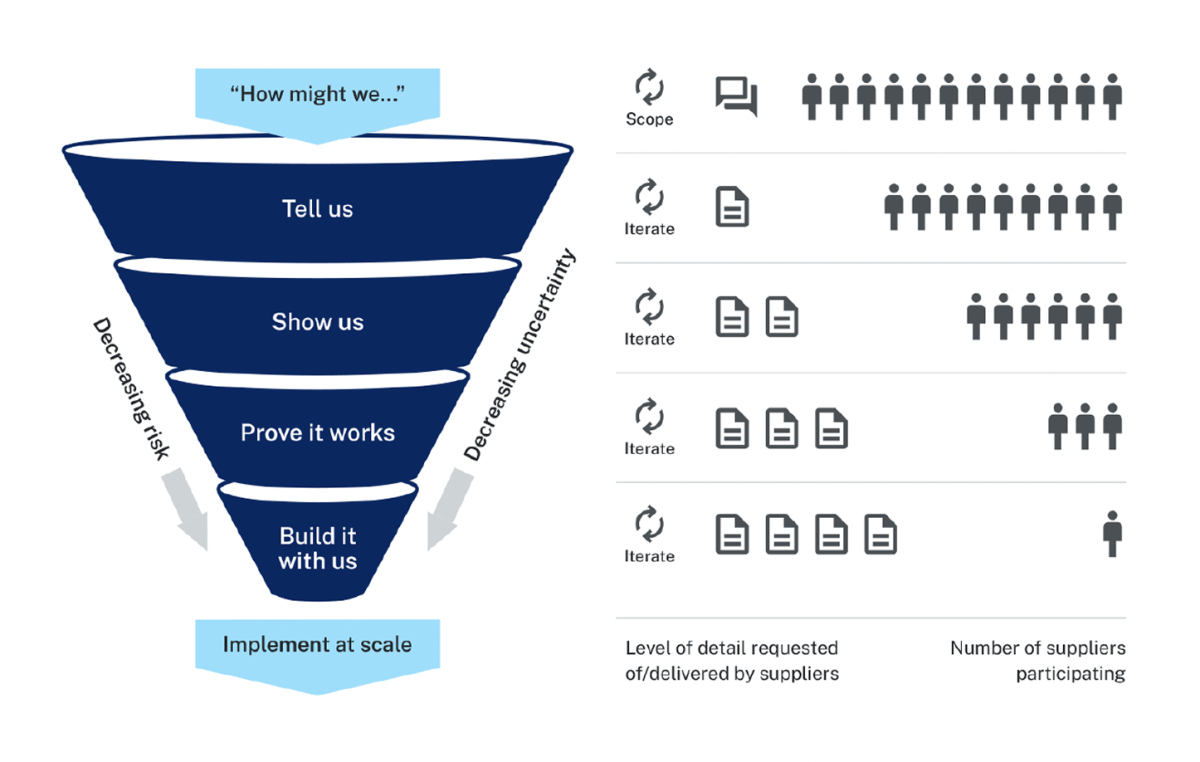Agile buying for the public sector
Learn how agile procurement can enable innovation outcomes, support governance and fulfil pubic sector obligations.
Agile procurement has the following features that help attract innovation and manage the uncertainty that comes with innovation:
- an outcomes-based, user-focused approach
- uncovering new information progressively and adapting the procurement process to it
- de-risking investment by breaking risks into more manageable chunks and taking smart risks
- a cross-functional team of experts designing and implementing together.
When used in the NSW Government, agile procurement also needs governance structures and processes that are designed to meet obligations around fairness, transparency and value for money.
Standard procurement governance structures and processes are geared towards known solutions and rely on certainty at a single gate; the approval to approach the market.
In agile procurement, governance structures need to accommodate learning and adapting while meeting NSW Government obligations. This creates multiple decision gates, which align with each stage of shortlisting and/or testing.
Figure 1 shows the agile public procurement framework. Starting with a challenge statement, it takes suppliers and potential solutions through a funnel in multiple stages of shortlisting.

The stages that make up the agile procurement framework are conceptual and flexible, with multiple engagement and testing methods available for each one. Each stage has a defined outcome that supports progressively building confidence before a final investment decision, by gradually decreasing risk and uncertainty. The stages and their associated levels of confidence are:
- Define the challenge - Assumes we don’t know the answer and are open to possibilities.
- Tell us - The proposal appears to solve the problem.
- Show us - The supplier seems to understand the operating environment and users.
- Prove it works - The solution is technically feasible.
- Build it with us - The solution is commercially feasible and suppliers are viable.
- Implement solution - The solution is viable at scale.
A note on agile procurement
Information and course materials relating to agile procurement is often based on private sector experience. Despite targeting procurement teams, these guides or courses may not support compliance with the NSW Government policies or obligations around fairness, transparency and value for money.
Buying teams trying to apply these materials to engage suppliers in trials or co-design through standard procurement may encounter barriers during planning or when attempting to implement at scale.
This page describes how agile procurement can be implemented in the public sector in a way that meets public sector obligations. Buying teams can follow the links to dedicated pages to access practical, step-by-step guidance and tools.
Apply the five agile public procurement components
Expand the headings below to learn more about applying the five agile public procurement components mentioned above:
An outcome-focused approach means that the final technical solution is not known, and the buyer is open to a range of possible solutions.
The preferred method for buying innovation aligns with the Human-Centred Design (HCD) double diamond stages of discover, define, develop and deliver, illustrated in Figure 2 below. Learn how the double diamond supports an agile approach to service delivery in Digital NSW.

Even though the activities in ICT project delivery differ from those in ICT innovation buying projects, the phases of agile delivery translate directly to procurement steps in the Test and Buy Innovation (TBI) buying journey.
- The Discovery and Define stages equate to the TBI scope step - problem shaping and defining the challenge. The buying team starts with user needs and gathers a wide range of data to understand the broader problem space before narrowing down to define a single challenge and desired outcome.
- The Alpha & Beta Develop stages equate to multiple TBI shortlisting and testing stages in a multi-stage procurement. The buying team takes the challenge statement to the market, asking for solution proposals and being open to many possibilities. They take promising solutions through the Show us, Prove it works and Built it with us stages, using the specific engagement methods that make up their unique buying pathway.
- The Deliver stage equates to implementation of the end solution. It only proceeds once a buying team has progressively tested, evaluated and shortlisted solutions and suppliers to find the best fit and best value to implement at scale.
Each unique buying pathway includes one or more testing stages to increase the buying team's knowledge of potential solutions and decrease the risk of the final investment decision. Each stage has deliverables and requirements that align with the stage objective. Buying teams request information or evidence from suppliers about how they can meet the requirements of the stage.
Buying teams can ask suppliers for just the level of detail or proof needed to achieve the aim of that stage. This approach avoids burdening suppliers with unnecessary documentation at the first stage. It asks a smaller number of suppliers for detailed information.
The staged approach shown in Figure 3 below also benefits buying teams. They can focus on assessing detailed and technical responses from a smaller and more relevant group of suppliers.

Developing a healthy risk appetite will help buying teams uncover innovation and achieve project objectives. This involves breaking the big risk of investing in an unknown solution and breaking it down into smaller risks through probity-rich testing and engagement. It means taking smart, well-managed risks in a probity-rich way that de-risks the final investment.
In practice, this means taking on practices that are perceived as risky but actively avoided. Because these practices bring benefits or help prevent much bigger risks, innovation procurement guidance provides as much support as possible to adopt them. Examples include:
- Compensating suppliers for a test stage: Even though this impacts project budgets, it also improves the appetite of diverse suppliers to participate. It is a more effective way to confirm which suppliers or solutions are suitable (or even confirm that there is no suitable solution or supplier) compared with making an investment decision based on documentation alone.
- Asking for less technical information from suppliers at the initial market approach: This leaves the buying team and their supporting ICT team with considerable uncertainty, but can attract more proposals for a wider range of suppliers. It can equip buying teams with insights into what details to evaluate more carefully at later stages for any unusual solutions.
- Working more closely with suppliers: This has the potential for suppliers to perceive unfairness or bias, especially where siloed interactions are involved. Conversely, it has the benefit of testing out suppliers’ ways of working, understanding of users and the best possible fit of proposed solutions.
In a multi-stage procurement, proof or testing stages need much smaller investments of time, resources and money compared to implementation at scale. Each stage represents a small financial risk that uncovers more information to reduce risk in the final investment.
Similarly, more interaction with suppliers through standard engagement methods like tender briefings, or even less traditional methods like pitch-fests and co-design workshops, can greatly improve supplier understanding of the problem and the suitability of their proposal. It can also improve the buying team's understanding of potential solutions and the buy-in of any other affected stakeholders involved in engagements. More interactive engagement methods create probity risks. However, those risks are manageable when teams are well-supported.
Innovation procurement guidance supports buying teams to take smart risks. This means helping teams to understand which risks can bring innovation or outcome benefits. It also means connecting them to measures that help manage the risks they do take.
With so much uncertainty involved in buying innovation, agile procurement needs subject-matter experts to go beyond just contributing to a section of a document. Buying teams should engage subject-matter experts when mapping out the buying pathway and designing each testing stage. This ensures the right technical information is received and evaluated at each procurement stage.
At the end of each stage, after evaluating new information, buying teams can revisit the scope of the stage that follows. They should re-engage subject-matter experts to refine the information needs and evaluation approach.
Buying teams and subject-matter experts work effectively when they are able to hear and build on each others' perspectives. Agile procurement involves buying teams including subject-matter experts in cross-functional, collaborative ways of working. Building this level of collaboration into an iterative model ensures that risks are uncovered, understood and mitigated in a timely and effective manner. It also helps all stakeholders continually improve their capability.
Guidance for innovation procurement recommends identifying stakeholders and mobilising a cross-functional, collaborative team before locking in the scope of the procurement or the procurement strategy.
Existing governance structures and procurement processes in the public sector are designed to achieve value for money, maintain transparency and fairness and codify these obligations into documented, defensible processes. Agile procurement can feel difficult because most templates, guides and practices aren't designed with it in mind.
In the context of innovation, agile procurement can drive improved governance, value and probity. Procurements with multiple stages create an opportunity for stage 'gates'. These allow buying teams to assess new information, adapt the procurement process, document decisions and communicate with stakeholders.
With a cross-functional, collaborative team of experts designing each stage, the buying team should be able to anticipate where new information may be uncovered during stages and what changes might happen at each gate. Accordingly, the team can build an informed, robust change management approach to give decision-makers confidence in the procurement process. They can then incorporate it into the buying strategy.
These gates, decision points and change management actions are also appropriate points to consider the probity implications of any new insights or adaptations. These might include:
- managing smaller changes through proactive communication with suppliers
- signalling predictable changes in advance
- assessing the impact of a change in deliverables against the scope of the initial market approach.
Where a change in deliverables may force a traditional procurement process to be restarted or cancelled, the outcomes-based approach to scoping makes agile procurement more resilient to changes in deliverables that still achieve the original outcome.